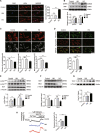High glucose induces Drp1-mediated mitochondrial fission via the Orai1 calcium channel to participate in diabetic cardiomyocyte hypertrophy
- PMID: 33637715
- PMCID: PMC7910592
- DOI: 10.1038/s41419-021-03502-4
High glucose induces Drp1-mediated mitochondrial fission via the Orai1 calcium channel to participate in diabetic cardiomyocyte hypertrophy
Abstract
Mitochondrial dysfunction and impaired Ca2+ handling are involved in the development of diabetic cardiomyopathy (DCM). Dynamic relative protein 1 (Drp1) regulates mitochondrial fission by changing its level of phosphorylation, and the Orai1 (Ca2+ release-activated calcium channel protein 1) calcium channel is important for the increase in Ca2+ entry into cardiomyocytes. We aimed to explore the mechanism of Drp1 and Orai1 in cardiomyocyte hypertrophy caused by high glucose (HG). We found that Zucker diabetic fat rats induced by administration of a high-fat diet develop cardiac hypertrophy and impaired cardiac function, accompanied by the activation of mitochondrial dynamics and calcium handling pathway-related proteins. Moreover, HG induces cardiomyocyte hypertrophy, accompanied by abnormal mitochondrial morphology and function, and increased Orai1-mediated Ca2+ influx. Mechanistically, the Drp1 inhibitor mitochondrial division inhibitor 1 (Mdivi-1) prevents cardiomyocyte hypertrophy induced by HG by reducing phosphorylation of Drp1 at serine 616 (S616) and increasing phosphorylation at S637. Inhibition of Orai1 with single guide RNA (sgOrai1) or an inhibitor (BTP2) not only suppressed Drp1 activity and calmodulin-binding catalytic subunit A (CnA) and phosphorylated-extracellular signal-regulated kinase (p-ERK1/2) expression but also alleviated mitochondrial dysfunction and cardiomyocyte hypertrophy caused by HG. In addition, the CnA inhibitor cyclosporin A and p-ERK1/2 inhibitor U0126 improved HG-induced cardiomyocyte hypertrophy by promoting and inhibiting phosphorylation of Drp1 at S637 and S616, respectively. In summary, we identified Drp1 as a downstream target of Orai1-mediated Ca2+ entry, via activation by p-ERK1/2-mediated phosphorylation at S616 or CnA-mediated dephosphorylation at S637 in DCM. Thus, the Orai1-Drp1 axis is a novel target for treating DCM.
Conflict of interest statement
The authors declare no competing interests.
Figures








Similar articles
-
Piezo1 deletion mitigates diabetic cardiomyopathy by maintaining mitochondrial dynamics via ERK/Drp1 pathway.Cardiovasc Diabetol. 2025 Mar 20;24(1):127. doi: 10.1186/s12933-025-02625-8. Cardiovasc Diabetol. 2025. PMID: 40114130 Free PMC article.
-
Melatonin prevents Drp1-mediated mitochondrial fission in diabetic hearts through SIRT1-PGC1α pathway.J Pineal Res. 2018 Sep;65(2):e12491. doi: 10.1111/jpi.12491. Epub 2018 Apr 14. J Pineal Res. 2018. PMID: 29575122 Free PMC article.
-
The Role and Mechanism of STIM1/Orai1-Regulated Ca2+ Influx in Myocardial Hypertrophy in Type 2 Diabetes Mellitus.Ann Clin Lab Sci. 2024 Jan;54(1):17-25. Ann Clin Lab Sci. 2024. PMID: 38514055
-
Sirt3 deficiency exacerbates diabetic cardiac dysfunction: Role of Foxo3A-Parkin-mediated mitophagy.Biochim Biophys Acta Mol Basis Dis. 2017 Aug;1863(8):1973-1983. doi: 10.1016/j.bbadis.2016.10.021. Epub 2016 Oct 26. Biochim Biophys Acta Mol Basis Dis. 2017. PMID: 27794418 Review.
-
The role of Drp1 in mitophagy and cell death in the heart.J Mol Cell Cardiol. 2020 May;142:138-145. doi: 10.1016/j.yjmcc.2020.04.015. Epub 2020 Apr 14. J Mol Cell Cardiol. 2020. PMID: 32302592 Free PMC article. Review.
Cited by
-
New therapeutic directions in type II diabetes and its complications: mitochondrial dynamics.Front Endocrinol (Lausanne). 2023 Aug 21;14:1230168. doi: 10.3389/fendo.2023.1230168. eCollection 2023. Front Endocrinol (Lausanne). 2023. PMID: 37670891 Free PMC article. Review.
-
Mitochondrial quality control in diabetes mellitus and complications: molecular mechanisms and therapeutic strategies.Cell Death Dis. 2025 Aug 27;16(1):652. doi: 10.1038/s41419-025-07936-y. Cell Death Dis. 2025. PMID: 40866350 Free PMC article. Review.
-
Matrix stiffness induces Drp1-mediated mitochondrial fission through Piezo1 mechanotransduction in human intervertebral disc degeneration.J Transl Med. 2023 Oct 10;21(1):711. doi: 10.1186/s12967-023-04590-w. J Transl Med. 2023. PMID: 37817199 Free PMC article.
-
Mitophagy in ischemic heart disease: molecular mechanisms and clinical management.Cell Death Dis. 2024 Dec 30;15(12):934. doi: 10.1038/s41419-024-07303-3. Cell Death Dis. 2024. PMID: 39737905 Free PMC article. Review.
-
IP3R2-mediated Ca2+ release promotes LPS-induced cardiomyocyte pyroptosis via the activation of NLRP3/Caspase-1/GSDMD pathway.Cell Death Discov. 2024 Feb 20;10(1):91. doi: 10.1038/s41420-024-01840-8. Cell Death Discov. 2024. PMID: 38378646 Free PMC article.
References
Publication types
MeSH terms
Substances
LinkOut - more resources
Full Text Sources
Other Literature Sources
Medical
Research Materials
Miscellaneous

